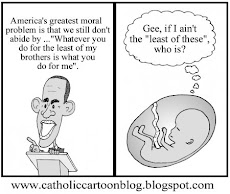I'm only one third of the way through and I'll try to blog again on this book when I'm finished reading it, but in the meantime I can't resist calling attention to the the clarity with which Pearce connects the eugenics movement of the early twentieth century with the population control movement that developed after the war and continues to this day.
Contrary to popular opinion, the goal of halting the swamping of the white race by the dark hordes that drove the early eugenicists did not dissipate after the Nazis gave racism such a black eye in the Western popular mind; rather it simply morphed into a concern for over-population. After noting that control of soaring populations was rising on the political agenda of the US after WW II, Pearce writes:
If one event put it there, it was a private meeting held in June 1952 in Williamsburg, Virginia, under the auspices of the National Academy of Sciences. Caldwell says it was a 'crisis conference', though it was by invitation only and produced no public outcome - not even in the specialist journals. The convener was John D. Rockefeller III, the 46-year old heir to the Rockerfeller family fortune made from Standard Oil. He was an American philanthropist with deeper pockets than any other. Next to him sat Vogt, whose fame from writing Road to Survival had won him the directorship of Margaret Sanger's Planned Parenthood Federation of America. Also at the table were America's two pre-eminent demographers, Frank Norstein and his former protege the Texan Kingsley Davis, along with both the young Osborns, Fairfield and Frederick, the latter an old friend of Rockerfeller's.In chapter 7, Pearce describes how what started as private philanthropy morphed into government policy and the role of the US in the forced sterilization campaign in India in the late 1960s. Lyndon B. Johnson became a convert to population control ideas and when India suffered from droughts in 1966 and 1967 and the US shipped a fifth of its wheat to India, he exploded: "Are you out of your f _ _ _ ing mind? I am not going to piss away foreign aid in nations where they refuse to deal with their own population problems" (p. 76)
These men were not troubled by modesty. They saw clearly their right to pronounce on the world's future. Frederick Osborn said they were part of a tiny intellectual elite 'of three or four hundred people who produce most of the freedoms of the human mind [who] may be engulfed by a great mass of people for whom these conceptions are largely alien.' They say the population problem 'not as a theory, but as a nightmare.' According to notes of the meeting unearthed by historian Matthew Connelly in the Rockerfeller archive, both Vogt and Fairfield Osborn argued that 'industrial development should be withheld' from countries like India, until they adopted population policies.
The three-day meeting decided to set up a Population Council to devise and bring about a global plan to control the world's population growth. Rockerfeller, who personally paid the council's salaries, was its first president. . . The council was soon busy taking in funds from the Ford and Rockerfeller Foundations. . . .
According to its website today, that opening meeting heard from John D. Rockerfeller that 'the reason to care about population was 'to improve the quality of people's lives, to help make it possible for individuals everywhere to develop their full potential.'" That may reflect its instincts today. But back then there was another, more hard-edged and Malthusian agenda.
Davis had told the Williamsburg meeting that food aid was worse than useless. Aid would build up ever larger populations on the basis of charity and it would become every more difficult to remove the prop. . . . Trade with undisciplined breeders was also deemed a bad idea . . . The old pre-war eugenic thinking also remained. The desire to cut population growth was surprisingly selective. Frederick Osborn, who resigned as president of the American Eugenics Society to take up his post at the Population Council . . . writing in 1956 in the Eugenics Review that 'we need the greatest number of births among genetically superior individuals.' (pp. 55-57)
India got the message and in 1967-68 it paid starving, lower-caste people $6 each to have a vasectomy. The report of the Bihar Ministry of Public Health said: "The large number of sterilizations during 1967-68 was due to drought conditions. Tribals and Dalits and other poor outcasts were disproportionately operated on. It was the compulsion of an empty stomach." (p. 77)
By the mid 1970s, voluntary sterilization was declining as most who wanted the operation had already had it. Compulsion was next.
At 3 am one November morning, police south of Delhi surrounded the Muslim village of Uttawar. the villagers were woken by loudspeakers ordering men over 15 years old to assemble at the bus stop. When they obeyed, about 400 were taken away, mostly to the holy Hindu city of Palwal, where they were forcibly sterilized. The village was singled out because it had protested against the sterilization plans. . . .This racist and imperialistic approach continues below the surface in most population control movements. It is less acceptable to speak today of the white race being swamped due to the defeat of Nazism and the whole over-population leading to massive famine scare has lost steam due to its having been proven false empirically. Now, the excuse for population control and eugenics is global warming and by the time it too has been proven false empirically it will have served its purpose of providing cover for the continuation of an anti-liberal, anti-humanistic, racist, eugenics that seeks to deal with poverty by eliminating the poor.
All over the country, even lowly government officials received targets for the number of 'volunteers' for sterilization that they had to bring to the camps. . . . The carrot had been replaced by the stick. Sterilization had become a condition of receiving everything from rickshaw licences to medical care, from irrigation water to ration cards. All across the country, state governments began jailing people with three or more children who refused sterilization. During the two years of the emergency more than 19 million sterilizations were carried out in India, three quarters of them on men.
As one Indian journalist later reported 'thousands upon thousands of people, mostly poor and illiterate, were herded like cattle to face the butcher's knife and then to become statistics of targets achieved two and three times over . . . Whether the person on whom the knife was wielded was 18 years old or 60, whether he was married or unmarried, whether he had six children or none, became matters of irrelevance since the objective was to tote up awesome figures as proof of loyalty to the powers-that-were in New Dehli.





No comments:
Post a Comment